MUNICH, May 12, 2022 /PRNewswire/ — At Intersolar Europe 2022, held at Messe München, Germany, Huawei shared its commitment to collaborating with partners and customers and empowering them with innovative FusionSolar Smart PV solutions for a better, greener, and smarter future. Under the theme of “Building a low-carbon smart society”, Huawei invited its global clients and partners to experience the progress and potential of solar power at its exhibition booth. Huawei demonstrated how it combines solar with storage and intelligence to accelerate the deployment of solar power as mainstream energy and enable industries and households to benefit from green electricity.
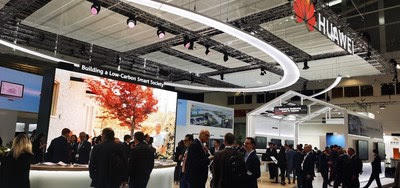
I. FusionSolar Smart PV Solution 6.0+: Safe, Reliable, and with Higher Yields
Huawei’s FusionSolar Smart PV Solution features the Smart String Inverter and has been widely recognized by customers for its delivery of clean solar power by integrating digital and power electronics technologies while promoting the digital and intelligent development of the PV industry.
A. Ensure Safety and Reliability for Power Plants
With increasing power in modules and inverters, safety on the direct current (DC) side has become a challenge for PV plants. After over two years of R&D efforts, Huawei launched the exclusive Smart String-Level Disconnector Technology (SSLD-TECH), achieving active DC disconnection and precise string-level disconnection. Based on an all-scenario design approach with high precision and fast response, SSLD-TECH accurately identifies and reliably cuts off common DC system faults. It can break reverse string connection/reverse current flow and inverter short circuit.
In terms of reliability, according to a report issued by TÜV in March 2022, Huawei’s Smart PV Solution has achieved a 99.999% availability based on the operation data of the 2.2 GW project in Qinghai, China. With durable modules and smart O&M, the world’s largest power plants can run smoothly and efficiently.
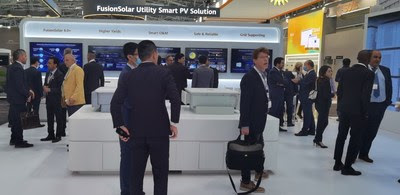
B. Grid Forming
Developed by Huawei, the intelligent grid connection algorithm enables a PV system to be adapted to various grid scenarios. Specifically, it enables excellent performance in terms of frequency and voltage in a weak grid environment and comprehensively improves PV power plants’ voltage and power control capabilities. When the value of SCR is as low as 1.2, the intelligent grid connection algorithm ensures that the inverter runs at full power without derating and successfully passes through high and low voltage continuously. This supports the stability of the power grid and addresses the global issue of large-scale grid-connected consumption of new energy.
In terms of power grid support, Huawei’s Smart PV & Storage Solution can be used to build a voltage source power station, which is compatible with the power grid. This verified that Grid Forming technology can increase the proportion of new energy access this year, based on the integration of optical storage.
The Grid Forming technology completes technical verification in a weak grid environment, further accelerating PV power generation from “Grid Supporting” to “Grid Forming”, and advancing solar power to become a main energy source.
C. Increase Power Generation and Make Optimal Investment
Huawei string inverters use multi-channel maximum power point tracking (MPPT) that solves the problem of string mismatch, and the Smart DC System (SDS) to achieve more than 1% increase in power generation through the integration of AI algorithms. In Guangxi, China, the solution increases power generation by 1.69%. Huawei cooperates with more than 10 brands of tracking solar panels to provide users with a better experience. Real-time data from multiple global projects shows that Huawei’s smart PV solutions can significantly increase power generation and help customers shorten their investment payback period.
D. Smart O&M
Smart I-V Curve Diagnosis 4.0 has revolutionized traditional operation and maintenance methods. It is like a “CT scan” offering a complete online full-scale inspection of 100 MW power plants in 20 minutes, and automatically generating diagnosis reports. It can also scan regularly within flexible times, providing a better user experience. In addition, it supports 14 types of fault diagnosis, with a converge rate of more than 80% of main faults. The key indicators of IV detection, the recognition rate, accuracy rate, and recurrence rate are all greater than 90%. This meets the industry’s highest level of CGC appraisal IV classification certification Level 4. In a real-life application, it helped the 30 MW project of a Malaysian customer save 2,000 hours of workload every year.
II. Smart String ESS: FusionSolar for Optimal Levelized Cost of Energy Storage (LCOS)
Energy storage plays an important role in electricity generation, transmission, distribution, and consumption within the clean energy system. An Energy Storage Solution (ESS) serves as a power reserve and a grid regulator and stabilizers simultaneously, providing valuable resources for peak shaving and frequency regulation.
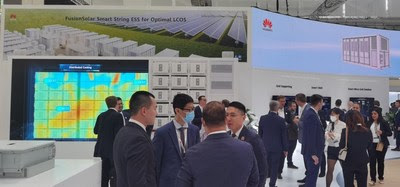
Due to cell mismatch, conventional energy storage solutions are characterized by limited capacity, short service life, complex O&M, and significant safety risk, inhibiting their widespread application. With over ten years of R&D experience in ESS, Huawei integrates digital, power electronics and energy storage technologies in a unique smart string structure to overcome the limitations of lithium batteries. Suitable for peak shaving and frequency regulation, Huawei’s Smart String ESS delivers a flexible and cost-effective solution with higher profit potential.
A. Optimal Investment
Huawei adopts four innovations to boost energy throughput in battery charging and discharging, offering a solution to cell mismatch.
- The pack-level optimization of Smart String ESS enables independent charging and discharging of cells to prevent mismatch loss.
- Rack-level optimization improves energy throughput by 15% or reduces the initial configurations by 15% at the same energy throughput by eliminating the risks of circulating currents.
- With distributed cooling, temperature difference in the container can be controlled within 3°C at a 0.5 C-rate, which extends the battery life by 50%.
- The all-modular design, efficient and reliable, cuts the levelized cost of energy storage (LCOS) by 20% and generates more revenue.
B. Simplified O&M
The problem of cell mismatch is intensified during the operation of a PV plant, which requires routine shutdowns for the manual calibration of battery state of charge (SOC). Through Huawei’s exclusive pack-level optimization, automatic SOC calibration is carried out without the need to pause operations. The easy replacement of faulty modules eliminates the need for onsite visits by experts, significantly reducing O&M costs. Pre-installed with battery cells, each container weighs less than 30 tons, making it easy to transport the container.
C. Safety and Reliability
Focusing on the end-to-end safety design, Huawei has implemented four-layer active shutdown and two-level passive isolation of ESS protection ensure all-around system safety.
In response to different business models, Huawei’s Smart String ESS can be deployed flexibly to create value for customers. Huawei energy storage solution achieves the streamlined management of battery discharging with the Smart Rack Controller, ensuring longer, constant power output which is critical to frequency regulation. At the same time, Huawei’s automatic SOC calibration and high availability address the industry challenges for ESS in frequency regulation scenarios, such as high SOC balance frequency and component failures, reducing operating expenses for customers. For peak shaving, the Pack Optimizer and the Smart Rack Controller increase power output by 15% during the life cycle, generating higher revenues for customers.
III. Commercial & Industrial Smart PV Solution 2.0: FusionSolar for a Sustainable Business
With increasing demand from enterprises to reduce electricity costs and carbon emissions, Huawei launched the 1+3 C&I Smart PV Solution 2.0, including an all-new three-phase inverter (SUN2000-50KTL-M3), a Smart String ESS (LUNA2000-200KWH-2H0), which can be coupled with the 100kW power conditioning system (PCS), and a smart PV optimizer (MERC-1100W/1300W-P). The C&I Smart PV Solution will help industries move into a low-carbon era with optimized electricity costs, active safety, and smart O&M for an enhanced experience.
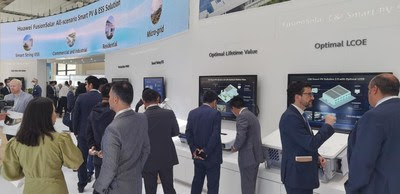
The electricity consumption of enterprises usually peaks in the daytime, and the consumption curve is comparatively consistent with the PV curve. Electricity costs can be significantly reduced by using PV power for self-consumption and selling the remaining power to the grid at feed-in tariff rates. The installation of an ESS further boosts the self-consumption rate to more than 80%, and by taking advantage of critical peak pricing, the production costs can be lowered. These solutions can help customers build a low-carbon environment with improved competitiveness for green development.
A. Optimal Electricity Cost: As seen from case study comparisons, Huawei’s C&I Smart PV Solution can increase power generation by more than 2% under the same conditions. To address shading issues commonly faced by the C&I sector, Huawei has launched the latest MERC-1100W/1300W-P optimizer, increasing installation volume by up to 30%. When the system capacity is elevated from 175kW to 200kW, 15% increase in installation volume can contribute 25,000 kWh of additional electricity. Thanks to its pack-level optimization, Smart String ESS improves energy throughput by 2%-5% during the service life, which further reduces the electricity cost.
B. Active Safety: The inverter is equipped with an AI-powered arc fault circuit interrupter (AFCI), which received the highest Level 4 certification from the CGC, to ensure safety for customers. The AFCI can detect arc fault locations in modules and distinguish noises from electric arcs, effectively eliminating false alarms and omissions. The combination of the leading SSLD-TECH and the AFCI provides dual protection for the system with precise DC fault detection and emergency disconnection. The four layers of ESS protection can prevent safety hazards, system faults and potential failures, drastically improving the system’s safety.
C. Smart O&M: The installation of the optimizer enables module-level management and the real-time monitoring of the power plant operation, cutting O&M costs by 50%. The automatic SOC calibration of the ESS saves personnel site visit and reduces O&M costs.
IV. Residential Smart PV Solution 3.0: FusionSolar for a Better Life
Following the launch of the “1+3+X” Residential Smart PV Solution 2.0 in 2021, Huawei presented the upgraded “1+4+X” design this year. Featuring a smart energy controller which connects a module controller, an ESS, an EV charger, and a management system, the integrated solution enables a smart power consumption ecosystem. This enhances PV self-consumption rate to 90% from 70% in the previous generation, bringing an all-around clean energy experience to homes with lower electricity costs, active safety, and intelligent assistance.
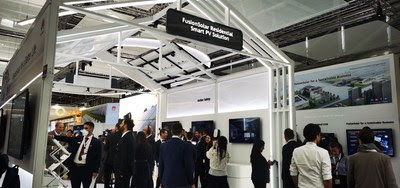
EV Charger (FusionCharge AC AP07/22N-EU): To enable low-carbon living, Huawei has launched a new solar EV charger for residential use with easy indoor and outdoor installation, delivering convenient fast charging.
A. Optimal Electricity Cost: Slimmer and lighter, the brand-new SUN2000-600W-P Smart Module Controller performs well for high-power modules. The flexible design coupled with the optimizer is suitable for any rooftop while supporting shading conditions and multi-directional installation. Power generation can go up by 27%, as seen in a pilot case study. Compact and stylish, Huawei’s Smart String ESS supports modular configurations and delivers high power throughput, allowing customers to enjoy efficient, clean energy.
B. Active Safety: The industry-leading AFCI technology can accurately detect arc faults and disconnect the inverter in 0.5 seconds. Meeting NEC 2017, which is one of the most stringent international safety standards, the smart optimizer supports automatic and manual activation in an emergency to bring the voltage of rooftop modules to zero. This helps to prevent electric shocks with rapid disconnection. The ESS also complies with VDE2510, one of Germany’s strictest standards in system safety. All of these minimize the safety hazards of a residential PV system to give customers peace of mind.
C. Intelligent Assistant: The AI energy management assistant EMMA can offer accurate estimations of PV power generation and household electricity consumption by learning from big data about weather conditions and user habits. It automatically adjusts the system for the best working mode, delivering clean solar power while ensuring comfort.
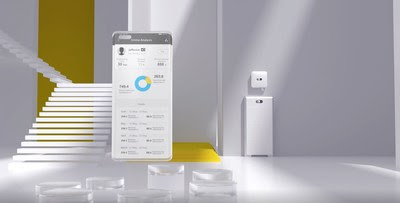
The combination of PV and ESS provides backup power during outages, ensuring the smooth running of important appliances such as security systems, lighting equipment and refrigerators, eliminating customers’ concerns about continuous power supply at home.
V. Smart Micro-grid Solution: Clean and Reliable Power Supply
According to World Bank, 840 million people live in off/unstable grid areas, where electricity from oil is still common. This traditional way of power generation results in high carbon dioxide emissions, high costs, and low efficiency, contributing to the widespread problem of the energy divide. Huawei has launched the Smart Micro-grid Solution to deliver optimal LCOE for 100 MW micro-grid projects with energy storage, providing a clean, safe, and reliable power supply with higher energy output and lower costs.
A. Optimal LCOE and Reliable Power Supply
The solution supports the seamless online transition of medium-voltage off/on-grid changeover and off-grid fault ride-through effectively to avoid power outage loss of US$2 million/MW compared to traditional power generation from oil. The solution delivers optimal power quality, helping to achieve zero-carbon generation and eliminate the energy divide.
B. Reduced System Costs
Compared to traditional power generation from oil, Huawei Smart Micro-grid Solution saves LCOE over 50%. Adopting a 2:1 PV/BESS ratio, the solution can reduce the initial configurations by up to 50%.
C. Active Safety
Equipped with SSLD-TECH, the Smart String Inverter enhances the active safety of power plants. The Smart String ESS features four-layer active shutdown and two-level passive isolation, preventing risks at the first place.
Huawei integrates information and communications technology (ICT), power electronics, and energy storage, and continues to collaborate with customers and business partners worldwide to build a low-carbon environment. The company is focused on achieving its goal of zero carbon and accelerating carbon neutrality for a greener, better future.
Photo – https://mma.prnewswire.com/
Photo – https://mma.prnewswire.com/
Photo – https://mma.prnewswire.com/
Photo – https://mma.prnewswire.com/
Photo – https://mma.prnewswire.com/
Photo – https://mma.prnewswire.com/
